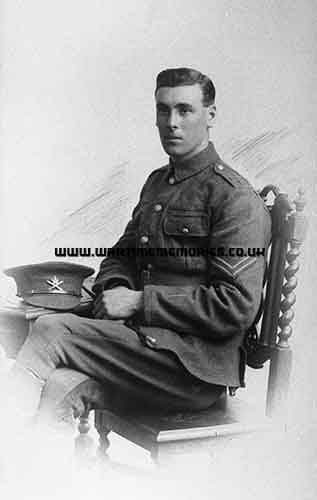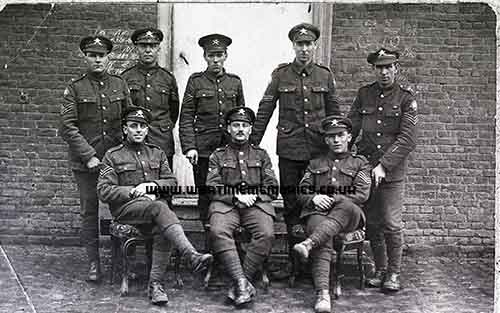Additions will be checked before being published on the website and where possible will be forwarded to the person who submitted the original entries. Your contact details will not be forwarded, but they can send a reply via this messaging system.
please scroll down to send a message
Sgt. John William "Jock" Boss MM.
British Army 42nd Battalion Machine Gun Corps
from:Hopetoun, West Lothian, Scotland
With the outbreak of the WWI, John Boss enlisted in the Royal Scots on the 16th of December 1914, and was assigned to B Company of the 1/8th Battalion. B company was located at Tranent, and had their drill station at Ormiston. His battalion initially took up position on the Scottish coastal defences. John received his six week gunnery training at the Training Centre at Belton Park, Grantham, Lincolnshire, and served in the Machine Gun section of the 1/8th Battalion. He was then sent to France around early to mid 1915 to join up with the battalion.
On the 24th of July 1916 John was compulsorily transferred to the Machine Gun Corps and was based temporarily for further training at the MGC base in Camiers on the northern coast of France. In early 1917, he was transferred to the 126th Brigade Machine Gun Company. On the 23rd of Feb 1918, the 126th Brigade Machine Gun Company, along with the 125th, 127th and 268th Brigade MG companies combined to form the 42nd Battalion Machine Gun Corps, attached to the 42nd Division of the British Army. Combining the machine gun companies took place to more efficiently utilise the Vickers guns and men. This allowed them to be moved quickly and placed where they were most needed, instead of remaining attached to specific brigades. It also allowed the division to develop and use sophisticated MG tactics, which became the hallmark of the MGC in 1918.
At this point the 42nd Battalion Machine Gun Corps was about 800 strong with 64 Vickers guns. The Battalion was divided into 4 Companies (A, B C and D), with each Company consisting of several Platoons. Each Platoon contained 8 sergeants, and each sergeant led a Section. By now a Sergeant John was in D Company, which was affiliated with the 126th Infantry Brigade, and he had charge of four Vickers machine guns and 24 men.
During 1918, Sergeant Boss with his 42nd Battalion Machine Gun Corps was heavily engaged in the battles along the Western Front. And it was near Solesmes, during the Battle of The Selle in October 1918, that She was awarded the Military Medal for bravery in the field. His citation read:
No. 44491 Sgt. J.W. Boss, 42nd Machine Gun Corps Awarded the Military Medal: For great gallantry and devotion to duty near Solesmes on 20th of October 1918. During the advance of his unit, one of his guns came under heavy fire with some of the team wounded. He personally mounted the gun and continued to fire until the "spare numbers came up". His magnificent conduct and gallantry during the operations have been a fine example to the men under him. Signed: A. Solly-Flood, Major General, Commanding 42nd Division.
With shells, both explosive and gas, accompanied by strafing machine gun fire from the German 25th Division. The decision had been made for a surprise night attack by the Third Army, at 2am on the morning of the 20th of October. However, before it could make the all-important thrust forward, the 42nd Battalion Machine Gun Corps and 42nd Division were tasked with the operation to push the allied line to the west, beyond the River Selle. It was during this action that his bravery won him the Military Medal.
The section of the Selle that the Third Army had to contend with was more difficult terrain than that further north and south, and heavily defended. The river was about 30feet wide and 6-8feet deep and all bridges had been destroyed, making advance of the Third Army impossible. Along the eastern side of the Selle was a railway embankment with branch lines forming an elongated triangular plateau, an ideal defensive position where numerous German machine gun posts had dug in. Above that was a very steep ridge providing the German 25th Division with the high ground covering the north, south and west.
On the evening of the 19th of October, D Company along with the 126th Infantry Brigade, moved into assembly positions west of the Selle River. The situation of the front during the day was relatively normal, with hostile artillery and machine gun activity. At 2am on the 20th of October, the offensive resumed. Conditions were dark with heavy rain and the slopes on the eastern side of the river muddy and slippery. The 42nd Battalion Machine Gun Corps was crucial in providing a barrage for the assault, as well as moving forward with the 42nd Division across the Selle. C company along with the Auckland NZ MG company provided the machine gun barrage cover for the 126th Infantry Brigade who, along with A and D companies of the 42nd Battalion MGC, pushed across the Selle River. Intense fire from enemy machine guns could be seen raining down onto the river while John in D company and A company carried their Vickers across with pack animals. Once the plateau was taken, both companies set up their HQs in the railway cutting. A and D companies proceeded to attack the ridge. During this operation they encountered hostile patrols, dug-in infantry and machine gun posts. Once the ridge and high ground to the east had been secured, A and D companies dug in to defend their position. From their positions, during the morning in very dull conditions with fine rain, they provided the barrage cover for the 127th Infantry Brigade, who pushed forward and leapfrogged the 126th Infantry Brigade. During this assault they fired 57,000 rounds fired from their Vickers. At around 13.00hrs, D company consolidated their position and A company took up fresh positions to protect the right flank, owing to the neighboring Division to the right of the 42nd Division not having been able to take the high ground. Later that afternoon, A and D companies provided barrage cover when the neighboring division re-attacked with the assistance of the 127th Infantry Brigade to gain and secure the high ground on the right flank.
The official war diaries of the 42nd Battalion MGC states "Throughout the day hostile artillery and MGs displayed great activity. The whole area was consistently shelled". The assault by the 42nd Division on the 20th of October paved the way for heavy artillery to be brought forward ready for the final assault on the 23rd October, through the town of Solesmes and onto Maubeuge.
John Boss survived the war, and soon afterwards immigrated to Mildura in Victoria, Australia. With the outbreak of WWII he enlisted in the Australian Army, served as a machine gun trainer and attained the rank of Warrant Officer II. He died in Mildura in 1975.

